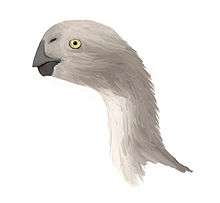Khaan
| Khaan Temporal range: Late Cretaceous, 84–75 Ma | |
|---|---|
 | |
| Holotype IGM 100/1127 | |
| Scientific classification | |
| Kingdom: | Animalia |
| Phylum: | Chordata |
| Clade: | Dinosauria |
| Order: | Saurischia |
| Suborder: | Theropoda |
| Family: | †Oviraptoridae |
| Genus: | †Khaan Clark, Norell & Barsbold, 2001 |
| Species: | †K. mckennai |
| Binomial name | |
| Khaan mckennai Clark, Norell, & Barsbold, 2001 | |
Khaan (/ˈkɑːn/; Mongol [χaːŋ] 'lord') was an oviraptorid dinosaur that was found in the Djadochta Formation of Mongolia and lived in the Late Cretaceous Period (Campanian), 75 million years ago.
Description

Khaan did not differ much from other oviraptorids. At first, its remains were assigned to "Ingenia", but the Khaan manual structure, lacking the expansion of the upper third metacarpal, was considered to differ sufficiently from that of "Ingenia" for it to be assigned to its own genus.
The oviraptorid diet is disputed, with plants and molluscs having been suggested. Like other oviraptorids, Khaan was probably at least partially a meat eater, feeding on small vertebrates like mammals, lizards and possibly other small dinosaurs. It was also probably feathered.
Discovery
The type species Khaan mckennai was in 2001 named by James M. Clark e.a. The genus name is derived from Mongol khaan, "lord" or "ruler". The specific name honours the paleontologist Malcolm Carnegie McKenna.
The holotype IGM 100/1127, consists of an almost complete skeleton found together with another specimen, IGM 100/1002. Together they were informally referred to as "Romeo and Juliet". These individuals are about four feet long. A third, considerably larger, specimen, IGM 100/973, was referred to the species.
Paleobiology

According to a 2014 study published in Nature, Khaan was possibly sexually dimorphic. Two specimens, the holotype MPC-D 100/1127 and referred specimen MPC-D 100/1002, were analyzed, the dimorphic feature being in the anterior chevrons. Both specimens were of the same size and build, and thus were likely the same age, ruling out ontogeny. In MPC-D 100/1127, the anterior chevrons showed great similarity to those of other theropods, with no great expansion on the distal end. However, in the other individual, the chevrons had a "heel"-like expansion above the distal end, which increased in size along the sequence. The study ruled out a possibly pathologic explanation, finding sexual dimorphism to have more support. It was thought that the reduced spines were a female characteristic, because they would increase space for laying eggs. Also, the larger spines could be for male muscle attachments, which would support a tail fan.[1]
Classification

Khaan was by Clark assigned to the Oviraptoridae. Among oviraptorids, it was probably more closely related to Conchoraptor.
The cladogram below follows an analysis by Fanti et al., 2012.[2]
| Oviraptoridae |
| |||||||||||||||||||||||||||||||||||||||||||||
See also
References
- ↑ Iv, W. S. P.; Funston, G. F.; Currie, P. J.; Norell, M. A. (2015). "A possible instance of sexual dimorphism in the tails of two oviraptorosaur dinosaurs". Scientific Reports. 5: 9472. PMC 4379468
 . PMID 25824625. doi:10.1038/srep09472.
. PMID 25824625. doi:10.1038/srep09472. - ↑ Fanti, F; Currie, PJ; Badamgarav, D (2012). "New Specimens of Nemegtomaia from the Baruungoyot and Nemegt Formations (Late Cretaceous) of Mongolia". PLoS ONE. 7 (2): e31330. PMC 3275628
 . PMID 22347465. doi:10.1371/journal.pone.0031330.
. PMID 22347465. doi:10.1371/journal.pone.0031330.
- Clark, J. M.; Norell, M. A.; Barsbold, R. (2001). "Two new oviraptorids (Theropoda: Oviraptorosauria), Upper Cretaceous Djadokhta Formation, Ukhaa Tolgod, Mongolia". Journal of Vertebrate Paleontology. 21 (2): 209. doi:10.1671/0272-4634(2001)021[0209:TNOTOU]2.0.CO;2.
